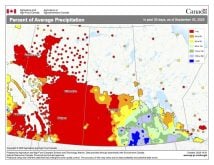I know at the end of my previous article that I said we would resume our look at severe summer weather by continuing our look at thunderstorms and why some of them produce extreme wind gusts, hail, and sometimes tornadoes. While the cool spring put a damper on thunderstorms, the building summer heat and an active weather pattern have brought some severe storms to our region over the last week or two. While thunderstorm activity has begun to ramp up across our region, I do want to take a short break from our look at thunderstorms to examine another severe summer weather event: high humidity.
While humidity is often linked with severe thunderstorms, humidity all by itself can be one of the deadliest forms of severe summer weather. What do I mean by that? Well, it has been estimated that with global warming, some parts of the world will soon (over the next 30 to 75 years) become uninhabitable for humans because of the impact of extreme humidity on the human body. Humidity is primarily measured in two different ways: relative humidity and dew point. Those of you who have been reading my articles over the years know that dew point is the best way to determine just how humid it is out, but more on that later. Research has shown that the human body cannot survive dew point temperatures above 35 C for more than a few hours. Up until just the last few years, the Earth has not recorded many occurrences of +35 C dew points. Now, we are starting to see an increasing number of these events.
In our part of the world, the highest dew points ever recorded are found in southern Manitoba. Carman recorded a dew point of 30 C on July 25, 2007, which is a Canadian record. Fortunately, these extreme dew points do not usually last very long — maybe for a few hours on one day or maybe two days in a row. In other parts of the world, these types of dew points are occurring and lasting for six to 12 hours a day for days on end. We also live in a developed country, which means most of us have access to air conditioning — either at home or somewhere else that has it. Now, imagine the most humid day you can remember; think what would happen if you could not go inside to cool off and those conditions lasted for several days with no significant breaks at night. You would eventually become hyperthermic, or overheated. This is what’s starting to happen across some subtropical regions. It will not take much more heating in these regions before they start to become uninhabitable for humans — which means these people will have to move somewhere.
Read Also

October rain recharges Manitoba soils
Daniel Bezte looks back on October weather on the Prairies and looks ahead to see whether there’s any consensus for this winter’s weather.
So misunderstood
OK, back to humidity and severe summer weather. Humidity, by its simplest definition, is the amount of water vapour that is in the air. The warmer the air, the greater the distance between air molecules and therefore, the greater the holding capacity of the air for water vapour. Conversely, when air is cooled, the distance between air molecules decreases, leaving less room for the air to hold water vapour. Because of this relationship, warm air has the capacity to hold much more water than cold air. The question is, by how much?
If we look only at the water-holding capacity of air at different temperatures and measure the amount of water by its mass (weight), we will find that for every 10 C increase in temperature, the holding capacity of the air for water nearly doubles. For example, air that is at 0 C can hold almost four grams of water for every one kilogram of air. If we warm that air up to 10 C the air could hold nearly eight grams, and by 30 C that same one kg of air would have the capacity to hold nearly 28 grams of water. When humidity is measured this way, it is referred to as specific humidity. While this is a useful way to measure humidity, it is not the way that we usually hear it reported.
The most common way humidity is reported is relative humidity. Unfortunately, it is probably one of the most misunderstood terms used in trying to describe the weather. Relative humidity is a ratio of the amount of water vapour that is in the air, compared to the maximum that it could hold under those same conditions, and is expressed as a percentage. Taking one of the examples from above, if we had an air temperature of 10 C and had eight grams of water vapour per kilogram of air, our relative humidity would be 100 per cent, calculated as follows:
Actual amount of water vapour in the air (8 grams) ÷ The holding capacity of the air at the current temperature (air at 10 C has a holding capacity of about 8 grams) x 100 = 100 per cent.
Now, if this same air was warmed up to a temperature of 30 C and the amount of water vapour in the air didn’t change, our relative humidity would be around 29 per cent [(8 grams ÷ 28 grams) x 100].
This is where the misunderstanding begins to develop. When the air temperature was 10 C and the relative humidity was 100 per cent, people would say that it is humid out, but once the temperature has warmed up to 30 C and the relative humidity dropped to 29 per cent, people would say that it is very dry out, but in reality, the amount of water vapour in the air has not changed; only the temperature has. This is particularly noticeable on humid summer days. In the morning we have had temperatures in the 16 C to 18 C range with relative humidities in the 100 per cent range — it’s humid out. By afternoon, with temperatures in the mid- to upper 20s, the relative humidity has dropped down to around 50 to 60 per cent and people now say it is dry out — but it’s not. It’s humid; the amount of water vapour in the air hasn’t changed!
















